Guest post by Ellice Wu, Nanyang Technological University, Singapore

2024 is shaping up to be a great year for exhibitions on women artists—and certainly no less for Angelica Kauffman (1741–1807). Kauffman was one of the leading artists of her time, working among a male-dominated artistic group in London and Rome during the second half of the eighteenth century. Known as a prodigy in Europe, even today we would still admire her multilingualism (she wrote letters in at least four languages of English, German, Italian, and French) and her prolific output in paintings, prints and drawings.
Kauffman and the Royal Academy
The Royal Academy of Arts (RA) in London has opened its long-awaited solo exhibition on the artist, running from 1 March to 30 June 2024. Initially planned to be held in conjunction with the Kunstpalast, Düsseldorf, in 2020, the London iteration was sadly cancelled due to the pandemic. Four years on, we are finally able to see a selection of her works across her life and career in the institution where Kauffman was a founding member in 1768.
As the exhibition shows, Kauffman worked mainly in the genres of history painting and portraiture. During the eighteenth century, the RA adopted the academic hierarchy of genres that placed history painting at the top. According to the gender distinctions of the time, men possessed the inventive and rational means to attempt the genre. Women instead were more suited to attempting the “lower” genres of portraiture and still life. Kauffman would show her ingenuity in subverting such tropes, successfully exhibiting history paintings and portraits at the annual exhibitions of the RA, and attracting significant commissions from male and female patrons alike.
Yet other than Kauffman’s ambitions to history painting, and her contributions to the popular form of portraiture, my particular interest in Kauffman’s work lies in her self-portraits. The medium of the self-portrait has garnered increasing attention, especially those made by women artists, seen to have claimed the genre for themselves to express their unique identity and experiences. Kauffman’s focus on the female experience is often emphasized in discussions of her work. But what of her own?
Self-Portrayal
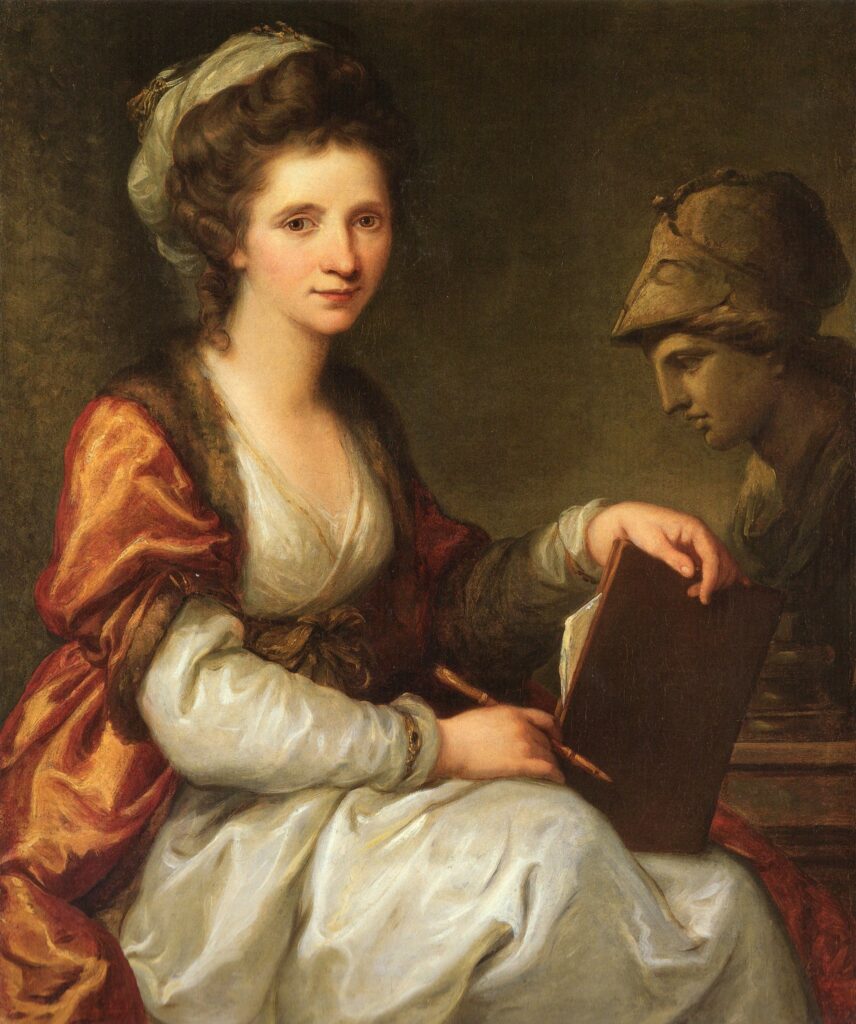
Kauffman consistently painted self-portraits throughout her life, beginning from childhood and through her career in London (1766–81) and Rome (from 1782 onwards). One of her finest self-portraits is her Self-portrait with Bust of Minerva, c. 1780–84. The picture shows a firm, matured style of self-depiction which Kauffman had honed over the years: portraying herself as an artist with her drawing tools of porte-crayon and portfolio in hand. In this image, the detail of the edge of her paper peeking out of her portfolio suggests that she is either beginning to draw, or has just completed—we cannot be certain which is the case—the image we see before us.
The inclusion of the bust of Minerva, the Roman goddess of wisdom and war strategy, and patron of the arts, sitting next to Kauffman, would also signify her importance to the artist. The depiction of Minerva may also indicate that Kauffman intends to appeal to a Roman audience, especially after she permanently re-settled in Rome in 1782.
Traversing Genres

The most complex composition among Kauffman’s self-portraits is her Self-portrait of the Artist hesitating between the Arts of Music and Painting, 1794. It is especially fascinating as the painting seems to traverse several genres. As well as a self-portrait, it is partially allegorical, and composed in the style of a history painting. The allegories of Music and Painting are instantly recognisable, with Music holding a piece of sheet music, and Painting with a palette and paintbrushes. Fashioned in a white neoclassical dress, which had become all the rage among women across Europe in the 1790s, Kauffman makes to stand as she bids farewell to Music, explaining her ultimate choice to pursue a painting career. The figure of Painting determinedly points to a temple in the distance, representing the pinnacle of fame.

In her recent book Women Artists in the Reign of Catherine the Great, Rosalind P. Blakesley describes how Kauffman’s figure of Painting draws on Raphael’s The Transfiguration, 1516–20. Looking closely, one does see that Kauffman references Raphael’s kneeling woman in the foreground, particularly in her side profile and her elaborate braided hairstyle. The identification of this detail in Kauffman’s painting process does, in my opinion, enhance the way we see and understand her works, especially as she learns from and imitates the Old Masters.
Music and Poetry
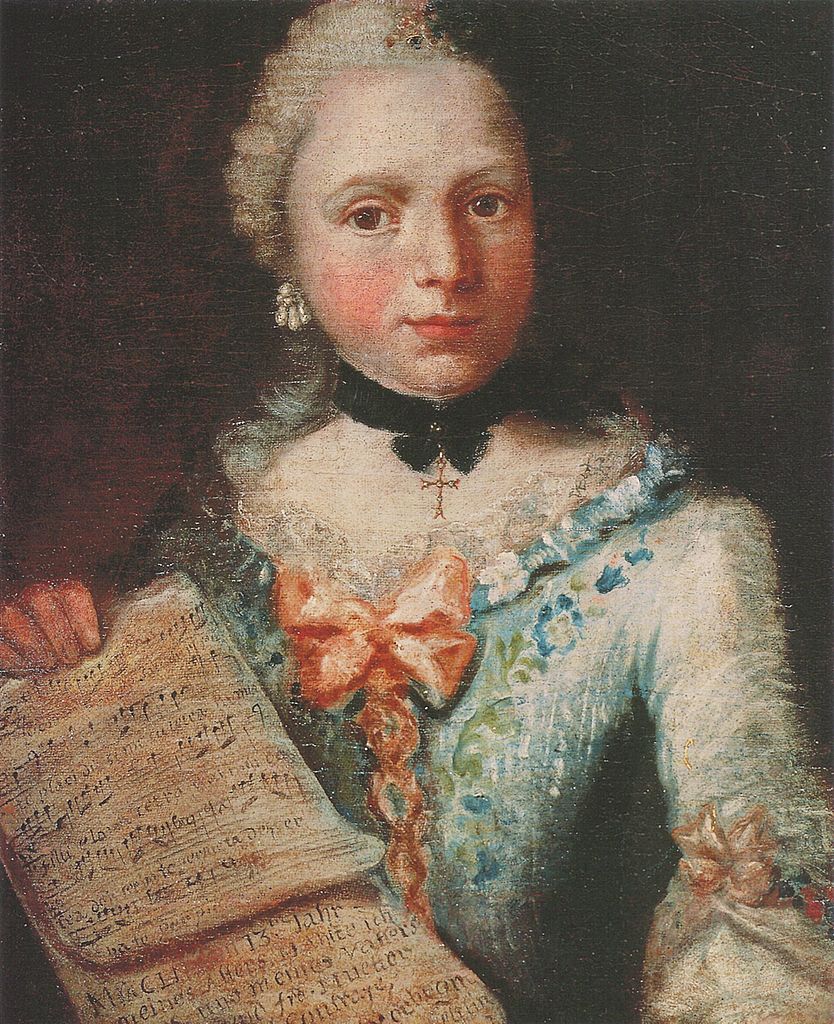
Painted late in her career, it is interesting that Kauffman does not choose to portray herself at her actual age, but uses the opportunity to reflect on her dilemma at a young age when she had to decide between two potential careers. Indeed, Kauffman’s earliest self-portraits as a young, emerging painter show her foremost as musically inclined, as in her Self-portrait with Sheet Music, 1753.
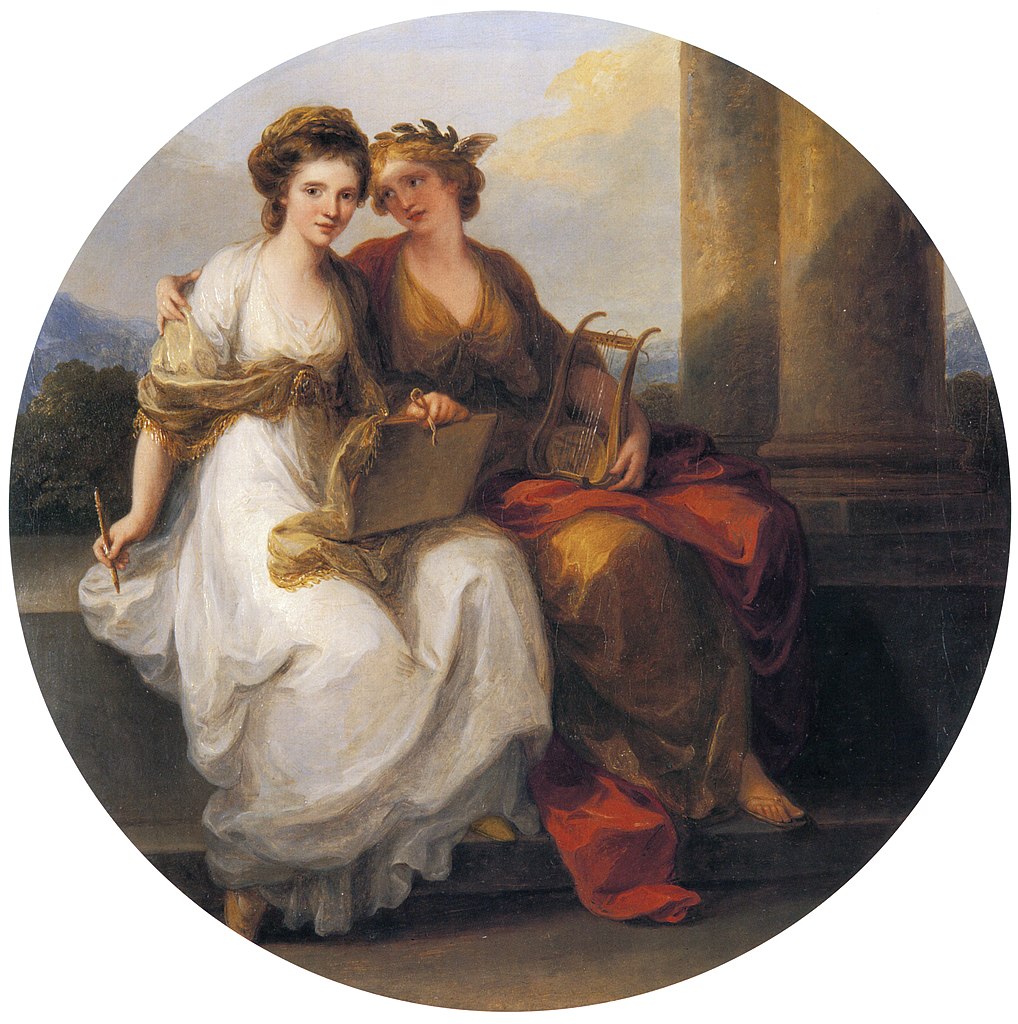
Another absolute favourite of mine is Kauffman’s inclusion of her self-image in The Artist in the Character of Design Listening to the Inspiration of Poetry, 1782. Now belonging to the beautiful collection of Kenwood House in London, Kauffman originally gifted this painting to her friend and long-time patron George Bowles. The art of gifting a self-portrait may perhaps be somewhat obscure to us now. Yet it is interesting to note how the creation of a self-portrait could be more than solely a personal activity for the artist. A record of one’s self could also be conveyed as a gift of gratitude and sign of friendship.
The English title now suggests that Kauffman allegorized herself as the “character of Design,” i.e. Disegno. However, the official record in Kauffman’s memoria delle piture, which her husband Antonio Zucchi managed, notes that Kauffman had in fact depicted herself as the figure of “Pitura” [sic], or that of Painting.
Allegory of Painting

The representation of the female artist as the figure of Painting, certainly, proceeds from Artemisia Gentileschi’s first portrayal of the theme in her Self-Portrait as the Allegory of Painting (La Pittura), c. 1638–39. Artemisia’s well-known example, alongside Kauffman’s Self-Portrait, c. 1770–75, from the collection of the Ramsbury Manor Foundation, is on display at the exhibition Now You See Us: Women Artists in Britain 1520–1920 at Tate Britain.
Kauffman would continue in this tradition, culminating in her most ambitious Self-Portrait as the Muse of Painting, c. 1787. Yet in this instance, as the memoria records, Kauffman as Pittura is intent on listening to the suggestions provided by the figure of Poetry. The figure of Poetry dons the traditional allegorical attribute of a laurel wreath atop her hair and her left hand holds a lyre.
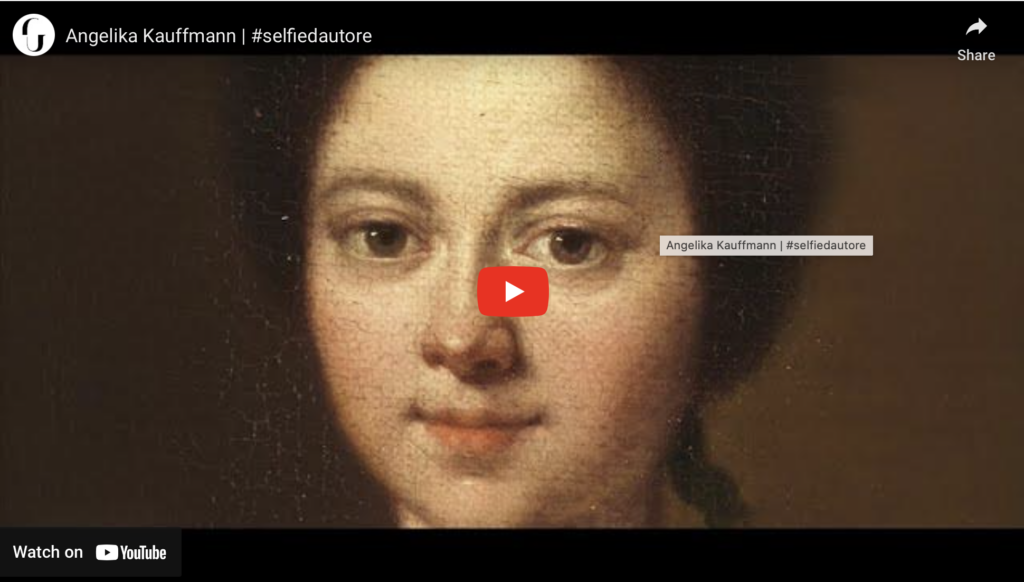
Though Kauffman ultimately decided to pursue painting as her career, certainly the “sister arts” of poetry and music were not far from her mind. We can see this from two prints made after Kauffman’s design of the allegorical figures of Poetry and Music.
Kauffman’s Designs in Prints
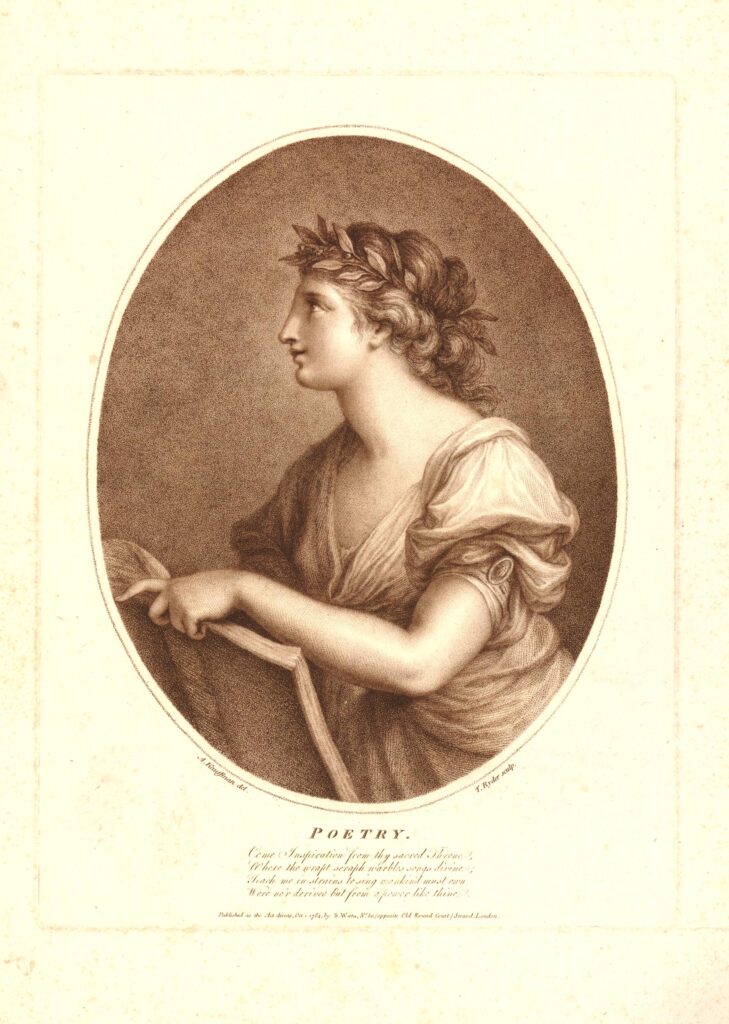
In a print of Poetry made by Thomas Ryder after Kauffman’s design, published by Simon Watts in 1784, the allegorical figure is similarly recognisable through her attributes of laurel wreath and lyre, while her hand holds onto a manuscript. The allegorical image of Poetry is, fittingly, accompanied by lines of poetry:
Come Inspiration from thy sacred Throne,
Where the wrapt seraph warbles songs divine;
Teach me in strains to sing mankind must own
Were ne’r derived but from a power like thine.

Perhaps Poetry could also be seen in line with another print of Music, reproduced by Simon Watts after Kauffman’s design a year earlier in 1783. The figure of Music holds a piece of sheet music, while her left hand plays the keys of a musical instrument. This author is working to identify fully the lines of poetry inscribed below the image of Music, as well as the sources of the poetry included in these two images. I welcome any suggestions or insights on this topic from readers.
It is interesting that the figures of Poetry and Music would appear in Kauffman’s oeuvre as allegory, and in her allegorical self-portraits in the 1780s. For all of Kauffman’s contributions to the art of painting, and to eighteenth-century European culture, she finds inspiration from the complementary arts of music and poetry.
Concluding Thoughts
Some critics today may like to see women artists in terms of their expression of “defiance” against the rigidity of artistic academies and education, and thus claim that Kauffman is contrarily too “soft” and “flawless.” Instead, I like to think that Kauffman developed her own introspective style in tune with art, music and poetry. She thus left her indelible mark on the history of European art in the eighteenth century, which continues to resonate with us today.
Ellice Wu is an art historian specializing in the field of eighteenth-century British art. She recently defended her PhD at Nanyang Technological University, Singapore, with a dissertation topic on Angelica Kauffman’s London self-portraits, 1766–1781. Her research interests lie in women artists and issues of identity, gender and display, allegory in word and image, and cross-cultural studies. She also writes at her art blog, Wording Art. Follow her on Instagram.
More Art Herstory blog posts about Angelica Kauffman:
Angelica Kauffmann: Grace and Strength, by Anita V. Sganzerla
Angelica Kauffman and Mary Moser: Founding Women Artists of the Royal Academy
Art Herstory resource page for Angelica Kauffman
More Art Herstory blog posts about 18th-century women artists:
Marie-Thérèse Reboul Vien: Finding the Natural in the Neoclassical, by Tori Champion
Madeleine Françoise Basseporte’s Hyacinths at the French Court, by Mary Creed
Adélaïde Labille-Guiard: Artist, Friend, Teacher, by Jessica L. Fripp
Seductive Surfaces: Anne Vallayer-Coster’s Vase of Flowers and Conch Shell at the Met, by Kelsey Brosnan
Marie-Guillemine Benoist, Revolutionary Painter, by Paris Spies-Gans
Exhibiting Women: The Art of Professionalism in London and Paris, 1760–1830, by Paris Spies-Gans
Mary Linwood’s Balancing Act, by Heidi A. Strobel
A Short Reintroduction to the Life of Anna Dorothea Therbusch (1721–1782), by Christina K. Lindeman
Rosalba Carriera at The Frick Collection, by Xavier F. Salomon
“I feel again the violence of a curious desire”: Rare client testimonies on Rosalba Carriera’s erotic art, by Angela Oberer
Rediscovering the Once Visible: Eighteenth-Century Florentine Artist Violante Ferroni, by Ann Golob




Trackbacks/Pingbacks